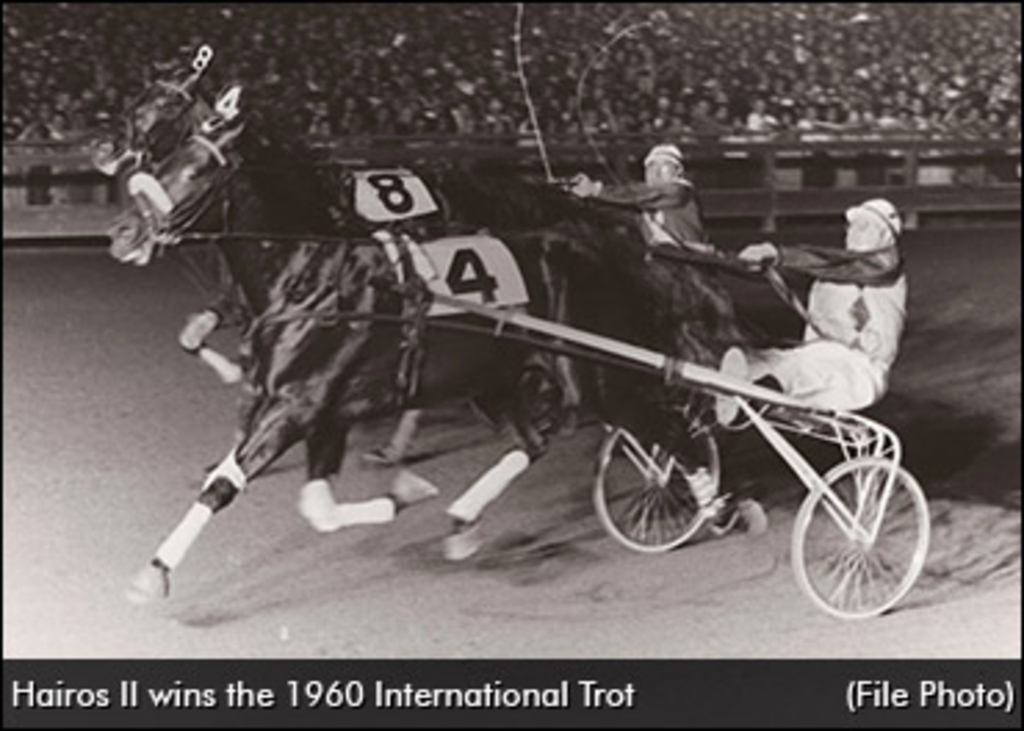
 The framers of the inaugural International Trot in 1959 could not have been more pleased with the way it was received and that over 48,000 fans attended the race spoke volumes alone. However, all involved were even more delighted with the race’s second edition at Roosevelt Raceway in 1960.
The framers of the inaugural International Trot in 1959 could not have been more pleased with the way it was received and that over 48,000 fans attended the race spoke volumes alone. However, all involved were even more delighted with the race’s second edition at Roosevelt Raceway in 1960.
Playing to a crowd of over 54,261, the crowd on-track was, and still is, an all-time attendance record at a night-time harness racing venue.
First-time champion Jamin dropped out of the 1960 race which gave tremendous confidence to Holland’s Willem Geersen, the driver/trainer of the vastly improved Hairos II.
A French-bred trotter, Hairos II, was purchased early in his career by Geersen for his Dutch connections, although the trotter at that time could not really be considered a serious threat amongst the elite group of potential competitors. But with his horsemanship and training knowledge Geersen developed Hairos II into a world class trotter who improved with every season. By 1960, at age nine, Hairos II was at the top of his game and was invited to race in America.
Geersen, racing under the flag of the Netherlands, was very confident that Hairos II was going to win. So much so that the rotund driver had no qualms when he asked "where is the press box?" since the winning driver was scheduled to be brought to the press box after the race.
The second edition of the International trot was raced at a distance of 1-1/4 miles, two furlongs shorter than the inaugural version.
Since Geersen was a big man, weighing more than 260 pounds, Hairos II was not given favourable consideration from the wagering public.
Despite being parked the whole way outside of Tornese -- the Italian entrant who had finished second to Jamin in the inaugural International Trot, Hairos II was victorious. Another Italian trotter Crevalcore, rallied to be second while the favoured U.S. Entrant, Silver Song was third.
And after giving his backers an $11.90 payoff the confident Willem Geersen was escorted to the press box to meet the international media and expounded on the virtues of Hairos II.
Now with a pair of International Trots already in the books many were questioning the supposed superiority of the American entrants which were yet to take a jaunt to the winner’s circle.
Hairos II was unable to defend his title in the 1961 race, after suffering a bowed tendon. At the 1961 International Trot, a French horse named Kracovie -- who had won that year's European circuit -- was missing a stablemate, either a mountain sheep or a goat that could not be brought into the United States due to quarantine regulations. Kracovie would not eat in the absence of its companion.
As described by George Vecsey in the New York Times, "The entertainer Tina Louise just happened to have a goat in her Manhattan apartment. Wearing a sleek and revealing dress, she, her agent and the goat paid a mission of mercy to Roosevelt.”
Despite the publicity, and the goat, Kracovie lost the race to Su Mac Lad, with Tie Silk third. Su Mac Lad, driven by the legendary Stanley Dancer finished in a time of 2:34.4 in driving rain and a sloppy track in front of 28,105 racing fans.
The following year (1962) before a crowd of 53,279, Su Mac Lad got corralled by Canada’s Tie Silk who had his revenge and Su Mac Lad had to settle for second money. But in 1963 “Summie” redeemed himself and turned back the Netherlands' Martini II in a driving finish.
That victory for the American entrant was followed in 1964 by yet another American horse, Speedy Scot, winning the International.
Over the years there was a competition as to which country would send out the most winners in the International Trots. Although France won the inaugural and then had a streak of five years in a row (1981-1985) with French trotters prevailing on the strength of three wins by Ideal du Gazeau and two by Lutin d’Isigny, their total of 13 winners was eclipsed by the United States' 15 wins. So it seems the rivalry will be renewed this year on October 10 after a twenty-year hiatus.
Sweden’s three International Trot wins is third best followed by Canada’s two victories. Denmark, Italy and the Netherlands trotters each had one win in the international event.
After the closure of Roosevelt Raceway in 1988 the International Trot was raced at Yonkers Raceway until 1995 when economics forced the race to be discontinued. However, it is coming back in grand style later this year at Yonkers Raceway on Saturday, October 10 and the invited entrants will race for a $1-million purse.
(SOA of NY)


Worth mentioning, Tie Silk
Worth mentioning, Tie Silk and Speedy Scot were driven by Keith Waples and Ralph Baldwin, members of the Canadian and United States Racing Hall of Fame.